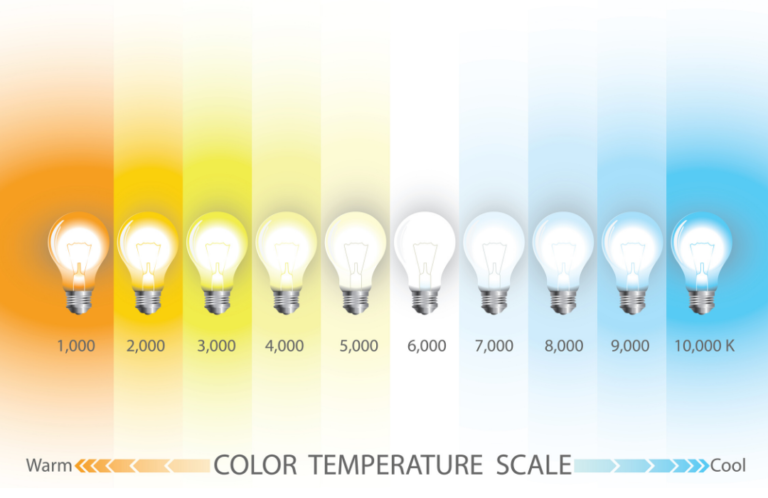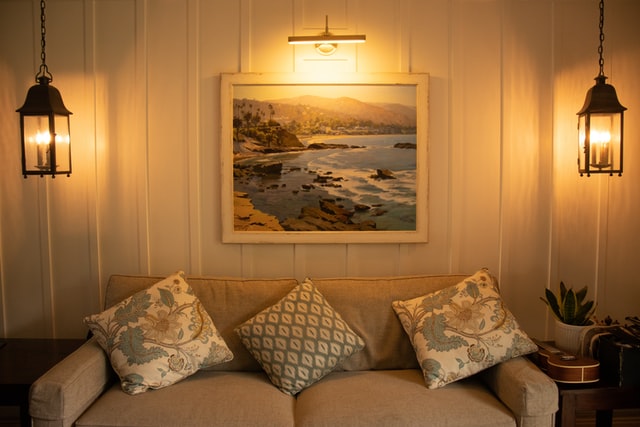What Colour Temperature Lights Should I Use? - PTX Electric
- PTX Electric
Lighting has the power to completely transform a space. From calm and cozy to bright and functional, the light’s colour temperature plays a crucial part in how we use light in our homes and workspaces.
Not sure what the differences are between warm and cool lights, or which colour temperatures to choose? And what on earth is Kelvin?
Read on to learn more about how lightning colour temperature is measured, and how to choose the ideal lights for your home.
What is colour temperature?

When we describe temperature in lighting, we’re referring to how warm or cool it appears. It’s measured using the Kelvin scale, abbreviated to K, a number between 1000K and 10000K. Usually, the best home lighting is between 2000K and 7000K, depending on how you’re using your lights. Anything above that is reserved for commercial or medical settings.
The lower the number, the warmer the light appears. The higher the number, the cooler or bluer it looks.
Different temperatures convey a specific look or feel in each room of your home.
What is the look and feel of each colour temperature?
Warm colour temperature

Lights less than 2000K create a yellowish-orange, dimly lit atmosphere similar to candlelight. If you want to create an intimate, cozy feeling, this colour temperature is perfect.
Between 2000K and 3000K are the best all-rounders for areas in your home where you want to convey a cozy, welcoming vibe with a bit more brightness. These are less orange and more of a brighter yellow.
Neutral colour temperature
Lights in the 3000K to 4500K range begin to look neither warm nor cool, instead giving off a bright white tone. A true neutral shade is around 3500K.
As it’s less comforting than a warmer colour, you could choose a neutral light in places where you carry out tasks to clearly see what you’re doing.
Cool colour temperature

Living room
A place to relax and unwind, your living room should feel comfortable and welcoming. To transform this space in your home, opt for warm yellow lighting to create an ambient atmosphere. Lighting in this space shouldn’t put a strain on your eyes, but instead feel soothing.
You could even mix warm colour temperatures together. For example, you could install a warm yellow bulb around 2000K to 3000K in your main living room light, and have candle bulbs with a temperature of less than 2000K for lamps in the corners of your room for a more intimate feeling.
Kitchen
The heart of the home, you might use your kitchen for lots of tasks. The main focus of your kitchen is cooking, preparing meals, and perhaps sitting to have breakfast and drinks.
A neutral tone is ideal for your kitchen area, as its bright, clear tones make it much easier to see what you’re doing. Opting for directional lights, such as a spotlight fitting, with bulbs at 3500K would offer clarity without harshness.
Dining or eating area
Eating with family and friends should feel relaxing and inviting, so it makes sense to choose similar temperature lighting to your living room.
You could try using a dimmer switch with warm-coloured bulbs to control the brightness, depending on whether you want a brightly lit table or something more subdued.
Garage or workshop
Here’s where you should select a cooler coloured lighting, as garages and workshops require focus and concentration. In these spaces you could be using power tools, dangerous equipment, and lifting heavy objects, so you need clear task lighting to avoid accidents.
A cool coloured bulb at 4500K or higher can offer this, whether you choose strip lighting to illuminate the entire room, or install bulbs in smaller, positional lamps.
Bathroom
To make personal grooming easier – whether that’s putting on your makeup, styling your hair, or shaving – you’ll need a bright, clear light.
As the bathroom’s purpose combines relaxing and concentrating (much like the kitchen), it’s a good idea to choose a neutral light. The white tone complements your bathroom suite, giving it a cleaner, more contemporary look. Bright neutral lights make it easier to focus, but without the severe intensity of a cool light.
Bedroom
As you might be aware, smartphones get a lot of bad press for keeping us up at night. That’s mainly due to your screen’s harsh blue tones, which have been found to interrupt our natural sleep cycles.
It makes sense that your bedroom lights should create a sense of calm, setting you up for a great night’s sleep. In this case, always opt for dim, warm coloured lighting in your ceiling lights and lamps.
Home office
While you can style your home office to be comfortable and full of personality, you still need to concentrate when you’re at your desk.
Neutral to cool lighting promotes concentration and helps you feel more awake. Having the light source directly next to or over where you work will make focusing easier.
Bulbs from 3500K upwards are a sensible choice for a home office.
Can you mix colour temperatures?
In theory, you can mix different colour temperatures in the same room, but do so with caution. It’s better to have your electrician fit bulbs strategically than placing bulbs haphazardly, risking a jarring appearance.
For example, let’s say you have an open-plan kitchen area that joins your living space. You may want to have warmer lights at one end of the room, with neutral lights where you’ll be cooking and prepping.
In most cases, it’s better to avoid grouping lighting from opposite ends of the temperature scale. The effect will be significant and it’ll be much harder to create the atmosphere you desire.
Conclusion
Now you know that lights play a significant role in enhancing different rooms.
Lights come in warm, neutral, and cool temperatures.
Warmer lights (at the lower end of the Kelvin scale) are more suited to cozy, welcoming environments. Cooler lights work best when you need to concentrate and see clearly. And it’s better to group similar colours together than cause headaches with mixed lighting!
